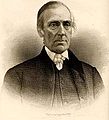Underground Railroad
| Advanced search |
- About 31 results found and you can help!
 Harriet Tubman (photo H. B. Lindsley), c. 1870. A worker on the Underground Railroad, Tubman made 13 trips to the South, helping to free over 70 people. |
The Underground Railroad was a network of secret routes and safe houses used by 19th-century black slaves in the United States to escape to free states and Canada with the aid of abolitionists and allies who were sympathetic to their cause. The term is also applied to the abolitionists, both black and white, free and enslaved, who aided the fugitives. Various other routes led to Mexico or overseas. While an "underground railroad" running south toward Florida, then a Spanish possession, existed from the late 17th century until shortly after the American Revolution, the network now generally known as the Underground Railroad was formed in the early 19th century, and reached its height between 1850 and 1860. One estimate suggests that by 1850, 100,000 slaves had escaped via the "Railroad". British North America, where slavery was prohibited, was a popular destination, as its long border gave many points of access. More than 30,000 people were said to have escaped there via the network during its 20-year peak period, although U.S. Census figures account for only 6,000. The Underground Railroad fugitives' stories are documented in the Underground Railroad Records.
| Underground Railroad Timeline Underground Railroad Timeline www.fergusbordewich.com/underground-railroad-timeline.html - Web |
| Archival footage of historian Eric Foner discussin... Archival footage of historian Eric Foner discussing the Underground Railroad in relation to Joanna Haigood's site-specific "Invisible Wings" dance and Jacob's Pillow Dance Festival in August 25, 2007 fora.tv/2007/08/25/Eric_Foner_The_Underground_Railroad - Web |
| Minutes of the second U.G.R.R. Convention for the ... Minutes of the second U.G.R.R. Convention for the State of Ohio, held in the city of Zanesville on the 6th, 7th and 8th of January, 1858. nrs.harvard.edu/urn-3:FHCL:4452888 - Web |
Gallery for «Underground Railroad»
- The escape.jpg
Average relevance
| Underground Railroad Stories from Southern Ohio, N... Underground Railroad Stories from Southern Ohio, Northern KY and Northwestern VA www.lawrencecountyohio.com/node/53 - Web |
| Africanaonline – A study of the Underground Railro... Africanaonline – A study of the Underground Railroad. www.africanaonline.com/slavery_underground_railroad.htm - Web |
| Tracks to Freedom: Canada and the Underground Rail... Tracks to Freedom: Canada and the Underground Railroad www.canada.com/ottawacitizen/features/freedom/ - Web |
| Underground Railroad Sites in Buffalo, NY Underground Railroad Sites in Buffalo, NY www.buffaloresearch.com/ugrr.html - Web |
| Annual historic re-creation of Underground Railroa... Annual historic re-creation of Underground Railroad in Sugar Grove, Pennsylvania www.paundergroundrailroad.com - Web |
| Friends of the Underground Railroad Friends of the Underground Railroad www.fourr.org - Web |
| The William Still National Underground Railroad Fo... The William Still National Underground Railroad Foundation www.undergroundrr.com - Web |
| National Underground Railroad Freedom Center National Underground Railroad Freedom Center www.freedomcenter.org - Web |
Low relevance
| National Park Service: Aboard the Underground Rail... National Park Service: Aboard the Underground Railroad www.cr.nps.gov/nr/travel/underground/ - Web |
| Maryland State Archives, Beneath the Underground: ... Maryland State Archives, Beneath the Underground: Flight to Freedom and Communities in Antebellum Maryland www.mdslavery.net/ugrr.html - Web |
| National Geographic: Underground Railroad National Geographic: Underground Railroad www.nationalgeographic.com/railroad/ - Web |
| Maryland's Cooling Springs Farm: The Story of a St... Maryland's Cooling Springs Farm: The Story of a Still-Existing Underground Railroad Safe-House www.coolingsprings.org - Web |
| Underground Railroad in Canada Underground Railroad in Canada www.pc.gc.ca/canada/proj/cfc-ugrr/commemoration/pg04_e.asp - Web |
| Tracks to Freedom – Canada.com special on the Unde... Tracks to Freedom – Canada.com special on the Underground Railway in Canada www.canada.com/ottawacitizen/features/freedom/index.html - Web |
| Freedom Crossing – Lewiston, New York Freedom Crossing – Lewiston, New York historiclewiston.org/freedom.html - Web |
| Ontario's Underground Railroad Ontario's Underground Railroad www.africanhertour.org - Web |
| Underground Railroad in Westfield, Indiana Underground Railroad in Westfield, Indiana www.wwhs.us - Web |
| Prospect Place mansion, Underground Railroad safeh... Prospect Place mansion, Underground Railroad safehouse in Trinway, Ohio www.gwacenter.org - Web |
| New-York Historical Society – Run For Your Life New-York Historical Society – Run For Your Life www.nyhistory.org/.../default.php?section=whats_new&page=run_for_your_life - Web |
| Underground Railroad Research Institute at Georget... Underground Railroad Research Institute at Georgetown College www.ugrri.org - Web |
| The Oberlin Heritage Center The Oberlin Heritage Center www.oberlinheritage.org - Web |
| Pathways to Freedom: Maryland and the Underground ... Pathways to Freedom: Maryland and the Underground Railroad pathways.thinkport.org - Web |
| NPS Underground Railroad Sites NPS Underground Railroad Sites www.cr.nps.gov/nr/travel/underground/states.htm - Web |
| Adventure Cycling Association's Underground Railro... Adventure Cycling Association's Underground Railroad Bicycle Route www.adv-cycling.org/ugrr/index.cfm - Web |
| Underground Railroad in Wisconsin, Wisconsin Histo... Underground Railroad in Wisconsin, Wisconsin Historical Society www.wisconsinhistory.org/.../index.asp?action=view&term_id=10455&keyword=fugitive+slave+law - Web |
| Historica’s Heritage Minute video docudrama about ... Historica’s Heritage Minute video docudrama about the Underground Railroad. www.histori.ca/minutes/minute.do?id=10166 - Web |
| Bresler, Joel (2007) "Cultural History of Follow t... Bresler, Joel (2007) "Cultural History of Follow the Drinking Gourd" www.followthedrinkinggourd.org - Web |
| Song, Story, or History: Resisting Claims of a Cod... Song, Story, or History: Resisting Claims of a Coded Message in the African American Spiritual "Follow the Drinking Gourd" www3.interscience.wiley.com/cgi-bin/fulltext/119393781/PDFSTART - Web |



